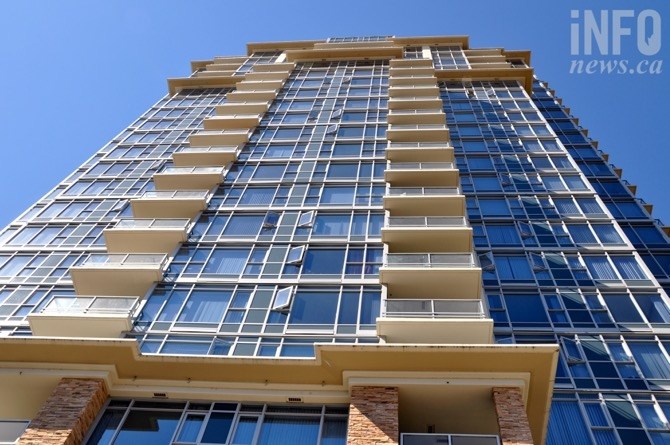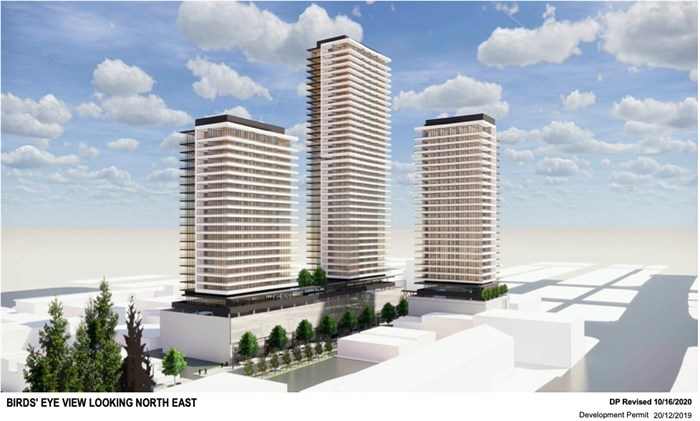
Waterscapes high-rise in Kelowna.
(JOHN MCDONALD / iNFOnews.ca)
February 15, 2021 - 6:00 AM
As developers keep pushing plans to lift Kelowna’s skyline higher – the latest being 46 storeys – firefighters aren’t worried about their ability to battle any blaze that may break out within those towers.
In fact, it’s the older four-storey wood framed apartments that give them their greatest worry.
“We have a concern if there is a fire in any building,” Kelowna fire prevention officer Paul Johnson told iNFOnews.ca. “But highrise buildings are engineered with many life saving features, such as stand pipes, sprinklers, fire alarms and smoke control measures. With that, and mirrored with the fact that it’s concrete and steel, the hazards, I think are greatly reduced.”
Johnson’s job is to review the building plans once they’re submitted to City Hall to make sure they meet all the regulations, then to inspect that work as the building goes up. That’s followed by annual inspections.
A highrise, for fire safety purposes, is any building more than 18 metres tall, or about six storeys.
Those are built with concrete floors, concrete walls and steel membranes.
“When a building is built, you’re essentially looking at three separate buildings,” Johnson said. “You’re looking at the main building then you’re looking at two stairwell corridors. Those corridors, when they’re constructed, have a two-hour fire separation – meaning it’s going to take direct flame onto that wall two hours before there’s a transfer of heat to the next space.”
That gives firefighters time to get up and residents time to get down to safety.

Redering of the Water Street by the Park on Leon Avenue. It has a development permit for three towers, the tallest being 42 storeys.
Image Credit: Submitted/City of Kelowna
Each stairwell has standpipes for firefighting purposes, separate from the residential water lines. These pipes are full of water and firefighters can connect their hoses to a tap on any floor and have 100 pounds per square inch in water pressure.
If there’s not enough pressure at any time, an alarm goes off. If there’s not enough pressure during a fire, a firetruck will be on site with a backup pump.
Inside each housing unit there are sprinklers, usually in every room, that are automatically activated to extinguish any fire. Each unit is “compartmentalized” so heat won’t penetrate through to the neighbouring unit for two hours.
Fire doors leading into hallways will hold back the heat between 45 and 90 minutes, depending on the building, Johnson said.
Then there are alarms throughout the building.
The halls are pressurized so smoke from inside a unit shouldn’t get into hallways but, if it does, the buildings are designed to vent it outside, often up through one of the stairwells.
“I’m not nervous about being in highrise buildings at all,” Johnson said.
With all that being said, some firefighters still have concerns about a serious shortage of manpower in Kelowna.
“In a worst case situation and the fire has developed, it requires a lot of manpower to get the equipment to the fire floor,” Troy Mamchur, president of the Kelowna Professional Firefighters Association, Local 953, told iNFOnews.ca. “As you can imagine, a lot of times elevators aren’t operational – look at 9/11, firefighters had to take the stairs all the way up. There’s a lot of equipment to take up. By the time you get there you’re exhausted. We carry 100 pounds of extra gear. That doesn’t account for all the other equipment we bring up.”
That equipment includes hoses, air tanks, tools to break down doors and more.
Then, they may need to turn around and carry residents with mobility issues back down those stairs.
The National Fire Prevention Association recommends 43 firefighters be able to reach a highrise fire within 10 minutes of being called. Kelowna only has 24 firefighters on duty at any one time.
Mamchur knows the city can’t afford to have that many firefighters on staff and does credit fire chief Travis Whiting with doing a good job of getting more firefighters on staff over the years but worries that it can take 20 to 30 minutes to get on-call staff to the fire or bring in help from neighbouring fire departments.
For his part, Johnson also says he would love to have 200 firefighters on staff but realizes that’s not economically feasible for the city.
Besides, he pointed out, the fire prevention association standards are recommendations, not requirements. Plus, most high rises have elevator systems that are protected against fires so hiking the stairs is not likely to happen. The World Trade Tower elevators, he added, were knocked out when planes crashed into the buildings.
Both men agree that the greater danger to residents and firefighters are the older four- to five-storey apartment buildings that are wood framed and don’t have sprinkler systems.
They generally have to be fought from inside the building. House fires, on the other hand, can be fought from the outside if it’s not safe to move inside.
Some of the older high rises in Kelowna don’t have sprinkler systems, Johnson said. But they still are built of concrete and steel so they do have that advantage.
To contact a reporter for this story, email Rob Munro or call 250-808-0143 or email the editor. You can also submit photos, videos or news tips to the newsroom and be entered to win a monthly prize draw.
We welcome your comments and opinions on our stories but play nice. We won't censor or delete comments unless they contain off-topic statements or links, unnecessary vulgarity, false facts, spam or obviously fake profiles. If you have any concerns about what you see in comments, email the editor in the link above.
News from © iNFOnews, 2021